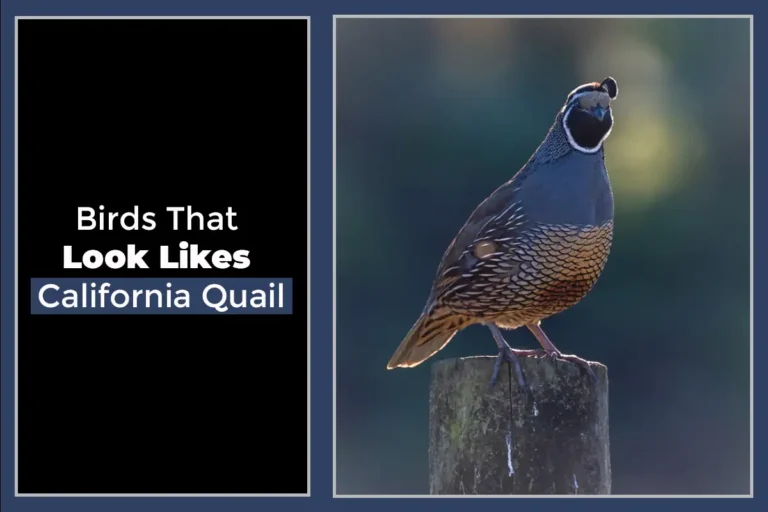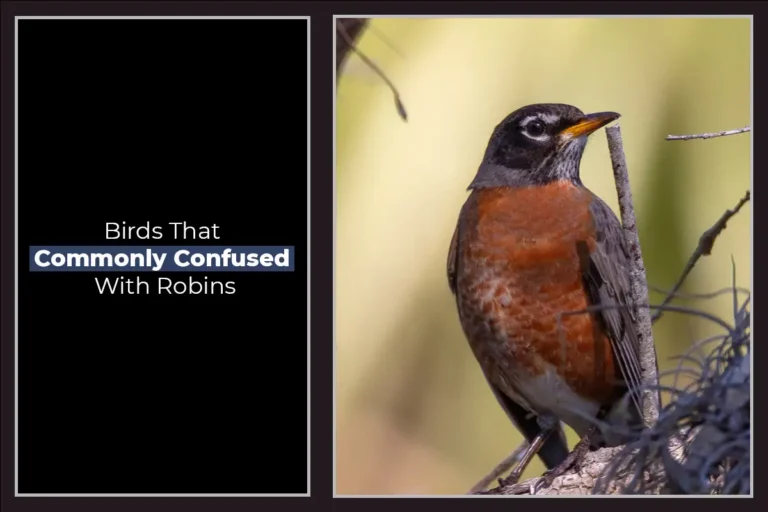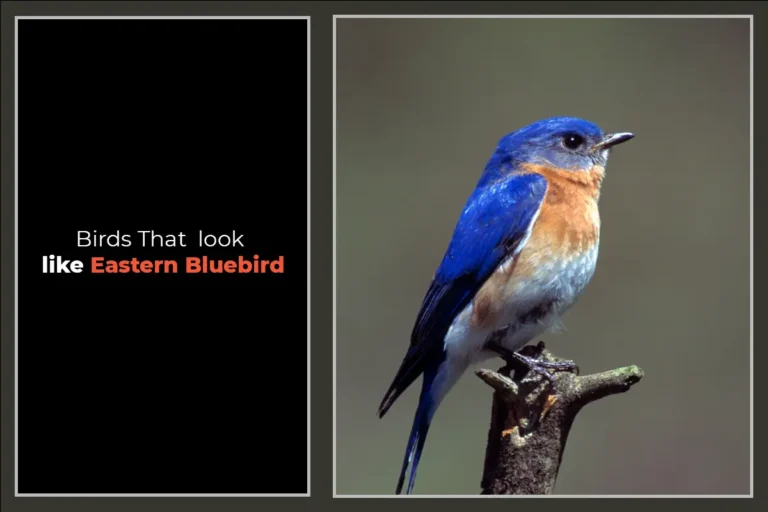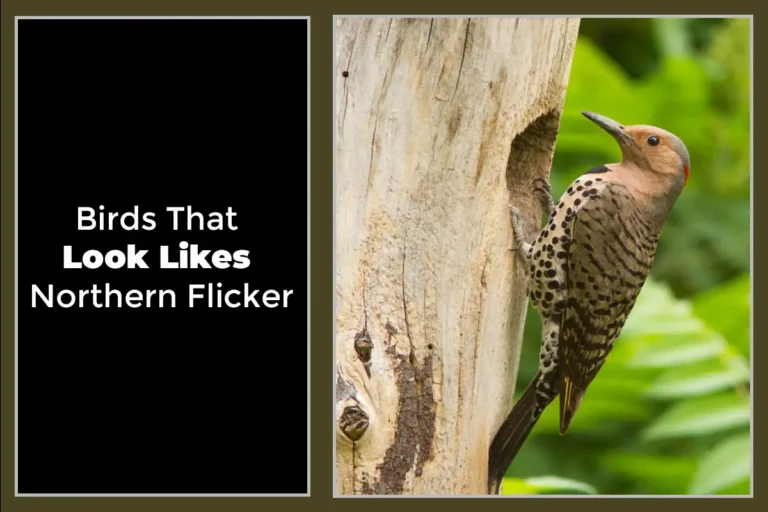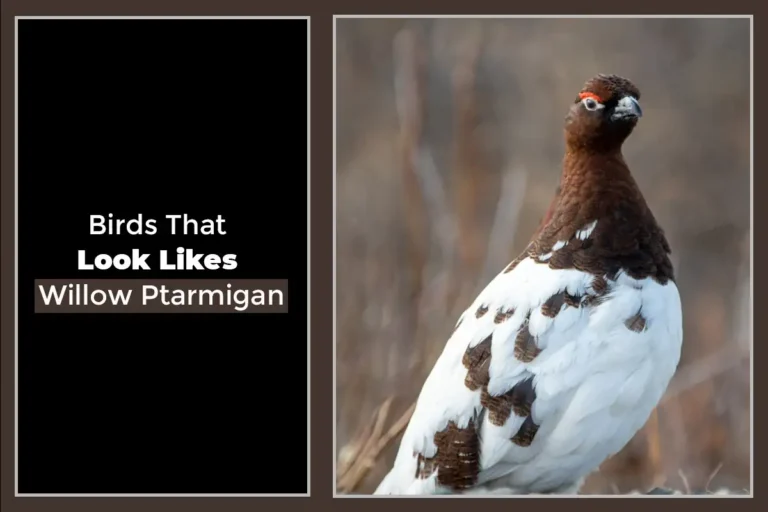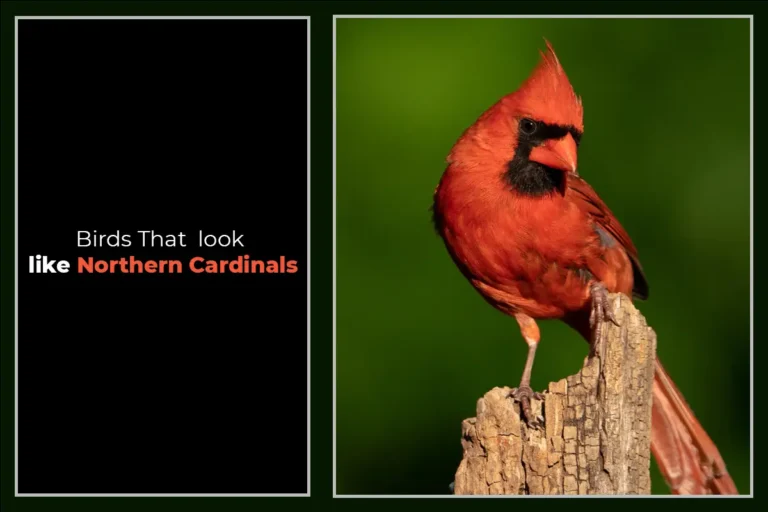8 Birds That Look Like Cactus Wren
Do you know which birds could easily be mistaken for the iconic cactus wren at first glance? With its eccentric rusty plumage and skyward cocked tail, the cactus wren is one of the most recognizable desert birds in North America.
But even experienced birders sometimes do a double-take when a similar species suddenly catches their eye. Nearly a dozen varieties of birds throughout the Americas bear a surprising resemblance to the cactus wren – and not necessarily the ones you might expect!
In this article, we’ll present the top 10 birds that look surprisingly similar to the cactus wren. You may be shocked to find out just how many wren and non-wren species could play the role of body double! Let’s take a look at these copycats out in the wild!
Looking for more articles about similar bird
01. Wrens Family
The Cactus Wren is one of 10 species of wrens that can be found in the United States. The resilient Cactus Wren endures the harsh Southwest desert, exhibiting shared wren traits along with specialized adaptations uniquely its own.
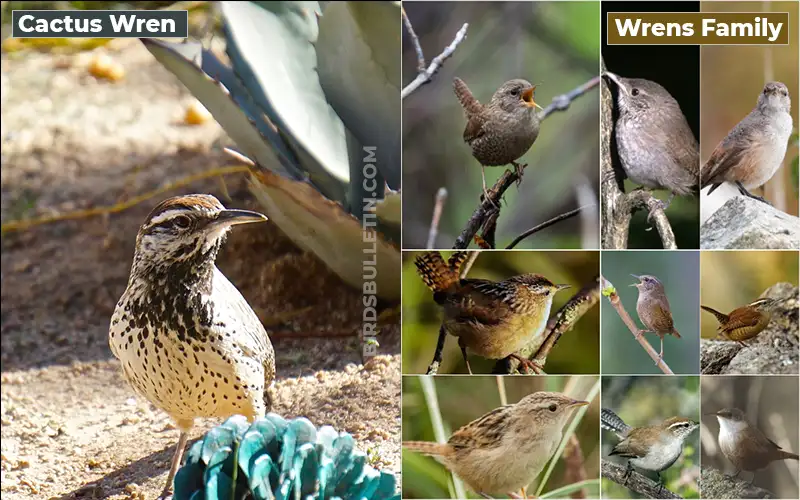
Let’s take a look at Common ground and Points of divergence in their family.
#1. House Wren
The House Wren (Troglodytes aedon) is a small, brown songbird found throughout North and South America. Weighing only 10-12 grams, it is one of the smallest wrens.
House Wrens are active, noisy birds that energetically hop and flit through vegetation as they forage for insects and spiders.
Similarities:
- Small songbirds with round, plump bodies
- Feed on insects and spiders
- Very vocal with complex, musical songs
Differences:
| Cactus Wren | House Wren |
|---|---|
| Found in hot, dry desert habitats | Found in backyards and open woods |
| Large wren with long tail and bill | Smaller wren with short tail |
| Lives year-round in breeding territory | Migratory; returns to breeding grounds each spring |
| Gets moisture from diet; doesn’t drink | Drinks water regularly |
#2. Marsh Wren
The Marsh Wren (Cistothorus palustris) is a small, secretive brown songbird found in freshwater and brackish marshes across North America. Weighing only 10-15 grams, it has a narrow white eyebrow stripe over its eye and its back feathers have a black-and-white spotted pattern.
Marsh Wrens eat insects and build domed nests of reeds and grasses lashed together over water. The male constructs multiple nests, with the female selecting one to lay 5-6 eggs.
Similarities:
- Feed on insects
- Males are polygamous and build multiple nests
Differences:
| Cactus Wren | Marsh Wren |
|---|---|
| Desert inhabitant | Lives in marshes |
| Stays in breeding territory year-round | Migratory |
| Lives in dry areas; don’t need to drink water | Lives around water |
#3. Carolina Wren
The Carolina Wren (Thryothorus ludovicianus) is a rotund songbird found in the eastern half of North America. Weighing 18-23 grams, it has a rich reddish-brown coloration, white eyebrow stripe, and barred black and white pattern on its wings and long tail.
The loud, ringing song of the Carolina Wren is a repeating “teakettle-teakettle” phrase. Carolina Wrens are energetic foragers, probing crevices and dead leaves with their long curved bills seeking insects and spiders.
Similarities:
- Paired mates tend to stay together year after year
- Sing complex and variable songs
Differences:
| Cactus Wren | Carolina Wren |
|---|---|
| Large wren found in dry, desert habitats | Smaller wren found in shrubby eastern woodlands |
| Light brown with bold white eyebrow | Rich reddish-brown with pale eyebrow |
| Doesn’t drink water | Drinks water regularly |
#4. Winter Wren
The winter wren (Troglodytes hiemalis) is a tiny brown songbird found throughout forests across North America.
Weighing only about half an ounce, these birds may be small but they have incredibly loud and complex songs. Winter wrens nest on the ground, building domed nests out of twigs, moss, bark, and leaves. They primarily eat insects and spiders.
Similarities:
- Small energetic songbirds
- Feed on insects and spiders
Differences:
| Cactus Wren | Winter Wren |
|---|---|
| Year-round resident of hot, deserts | Migrates; breeds in cool evergreen forests |
| Has a longer bill and tail | Plump with a very short tail |
| Gets moisture from food; doesn’t drink water | Drinks water regularly |
#05. Sedge Wren
The Sedge Wren (Cistothorus platensis) is a small songbird found in North and South America. It gets its name from its habit of nesting and living in sedge meadows, grassy marshes, and wet fields. At only 4-5 inches long, the Sedge Wren is rather diminutive with brown upperparts and a pale underside with buffy streaking.
These birds mainly eat insects and spiders. They forage low in dense vegetation, clambering through stems in search of prey. Their small size allows them to pick through dense marshes that would impede larger birds.
Sedge Wrens are migratory, breeding in the northern parts of their range in summer and migrating south for the winter. They build domed nests out of grasses and plant material, placed just above wet ground or water.
Similarities:
- Well-camouflaged in their respective habitats
- Difficult to observe in dense vegetation
Differences:
| Cactus Wren | Sedge Wren |
|---|---|
| Common, conspicuous desert bird | Secretive marsh wren are rarely seen |
| Sandy brown plumage blends into the desert habitat | Streaked brown plumage hides in dense grasses |
| Loud, raspy vocalizations | Softer buzzy trills for songs |
#06. Bewick’s Wren
Bewick’s Wren (Thryomanes bewickii) is a small songbird found in North America. With a long tail and brown feathers, it gets its name from Thomas Bewick, an engraver who illustrated the first scientific descriptions of the bird.
These birds are found across the southern and central United States as well as parts of northern Mexico. They prefer brushy habitats like thickets, gardens, and scrublands. These vocal and energetic birds use their thin pointed bills to feed on insects and spiders.
Similarities:
- Long, slender downcurved bill for probing
- Feed on insects and spiders
Differences:
| Cactus Wren | Bewick’s Wren |
|---|---|
| Large desert wren with bold white eyebrow | Smaller wren with white eyebrow stripe |
| Sandy brown color blends into desert rocks and sand | Gray-brown upperparts; light underparts with barring |
| Found in hot, arid habitats year-round | Migrates out of breeding range in winter |
#07. Rock Wren
The Rock Wren (Salpinctes obsoletus) is a small brown songbird found in rocky, mountainous areas of the western United States and Mexico. Sometimes called the Canyon Wren, this tiny wren uses its long curved bill to probe into crevices for insects and spiders.
With pale buff undersides, dark barring on the wings and tail, and a faint eye stripe, the Rock Wren blends into rocky slopes remarkably well. Its call is a high-pitched “tweep” while its song is a mix of musical warbling and harsh trills.
Similarities:
- Naturally found in rocky, arid habitats in the western U.S.
- Feed on insects and other small invertebrates
Differences:
| Cactus Wren | Rock Wren |
|---|---|
| Lives in hot desert environments | Prefers cooler, higher-elevation rocky areas |
| Large with long tail and bill | Smaller wren with thinner bill |
| Sandy brown color | Pale gray-brown with white speckles |
#08. Canyon Wren
Canyon wrens (scientific name: Catherpes mexicanus) are a species of small brown songbirds in the wren family that inhabit rocky canyons and cliffs in the western part of North America.
They have long dark bills with a slight downward curve, streaky brown, and buff-colored plumage, and long tails which they often hold upright. Canyon wrens skillfully climb up and down steep canyon walls and nest in holes or crevices along cliffsides.
These birds primarily feed on insects and spiders but will also eat berries and seeds.
Similarities:
- Found in rocky areas of western North America
- Do not drink water
Differences:
| Cactus Wren | Canyon Wren |
|---|---|
| Inhabits hot, sandy deserts | Lives along rocky cliffs and canyons |
| Light build with long tail | Stocky with a shorter tail |
| The song is harsh and buzzy | The song is melodic with a descending pitch |
#09. Pacific Wren
The Pacific wren (Troglodytes pacificus) is a small brown songbird found along the Pacific Coast region of North America.
It belongs to the wren family and has many adaptations suited to damp coniferous forests, including barred brown and buff-colored feathers that provide camouflage in its shady habitat. Pacific wrens inhabit areas from southern Alaska down into northern California, preferring dense undergrowth near streams or creeks.
They build intricate round nests out of moss, twigs, bark, and leaves. Though tiny at only about 4 inches long, Pacific wrens have surprisingly loud songs and calls to attract mates and defend their territory.
Similarities:
- Small energetic songbirds
- Males sing complex songs
Differences:
| Cactus Wren | Pacific Wren |
|---|---|
| Sandy desert inhabitant of southwest U.S. | Forest dweller of the Pacific Northwest |
| Light build with long tail and bill | Plump with a very short tail |
| The song is a dry buzzy rasp | The song is sweet lyrical trill |
02. Sage Thrasher
Appearance and Identification
Around the same size as the cactus wren, the sage thrasher (Oreoscoptes montanus) sports brown upperparts and lighter underparts with dark streaks.
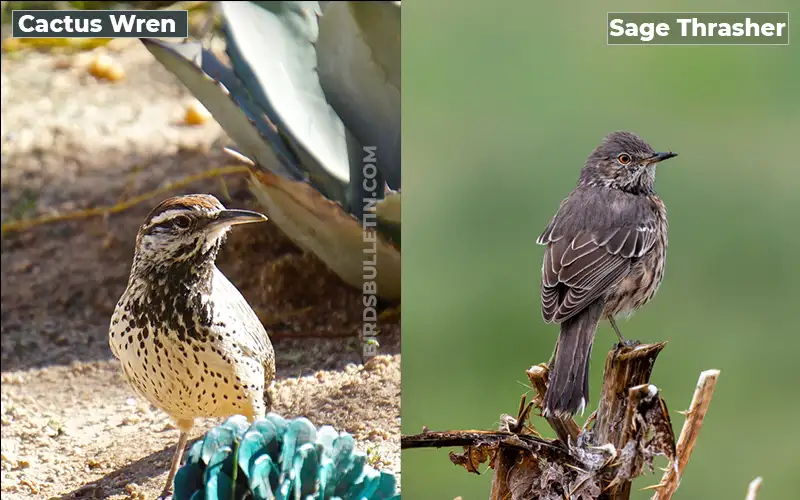
Its long bill and bright yellow eyes can be confused with the cactus wren.
Geographic Range and Habitat
Unlike the cactus wren, sage thrashers occupy sagebrush plains and scrublands across western North America instead of the Sonoran and Chihuahuan deserts.
Similarities and Differences
While sage thrashers lack the crisp facial markings of cactus wrens, their heavily streaked breasts distinguish them upon closer inspection. Their songs also diverge, with the sage thrasher delivering more melodious warbling notes.
03. Curve-billed Thrasher
Description
Sharing the infamous curved bill of the cactus wren, the curve-billed thrasher exhibits sex differences in plumage.
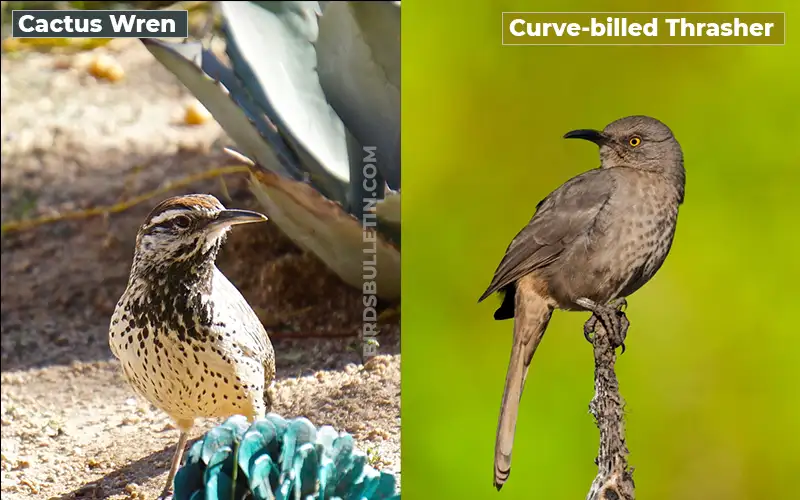
Males display bright rusty upperparts and heavily spotted underparts, while females and juveniles appear more nondescript grayish-brown.
Habitat and Range
Curve-billed thrashers closely overlap with cactus wrens throughout desert scrub from California to Texas to central Mexico. However, they tend to occupy thicker brush than cactus wrens.
Comparisons
Despite the similarities, curved-bill thrashers have longer tails and lack the bold white eyestripe of the cactus wren. Their melodious songs also stand out from the cactus wren’s cacophonous calls.
04. Bendire’s Thrasher
Identifying Features
Bendire’s thrasher shows subtle variation across its range, with two subspecies exhibiting divergent plumage.
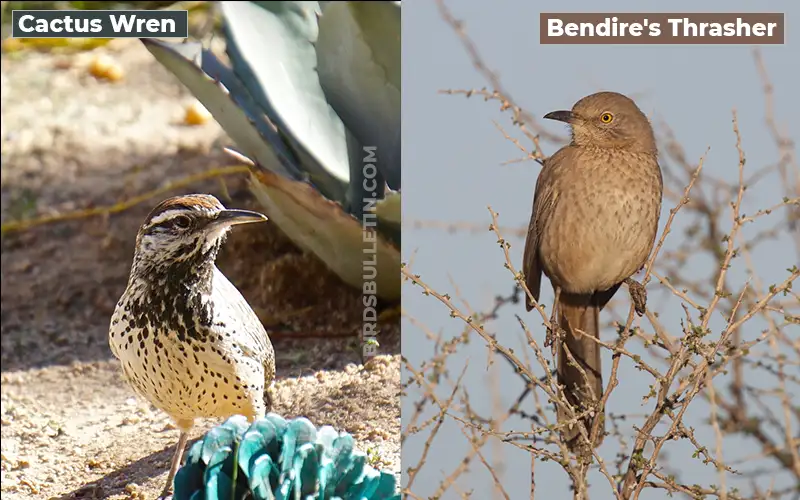
Generally, it sports a longer bill and brighter rusty coloration on the wings and tail compared to the cactus wren.
Distribution and Habitat
This thrasher occupies areas of the southwestern U.S. and Mexico but differs by tending to inhabit dense thickets rather than the relatively open stands of cholla and prickly pear cacti frequented by cactus wrens.
Points of Comparison
The vibrant rusty hues of Bendire’s wings and tail distinguish it from the more uniform brown plumage of the cactus wren. It also lacks the crisp facial markings that set the cactus wren apart.
05. Northern Mockingbird Juvenile
Visual Attributes
During their first year of life, northern mockingbirds closely resemble cactus wrens with their gray-brown plumage. However, mockingbird tails tend to appear longer in flight.
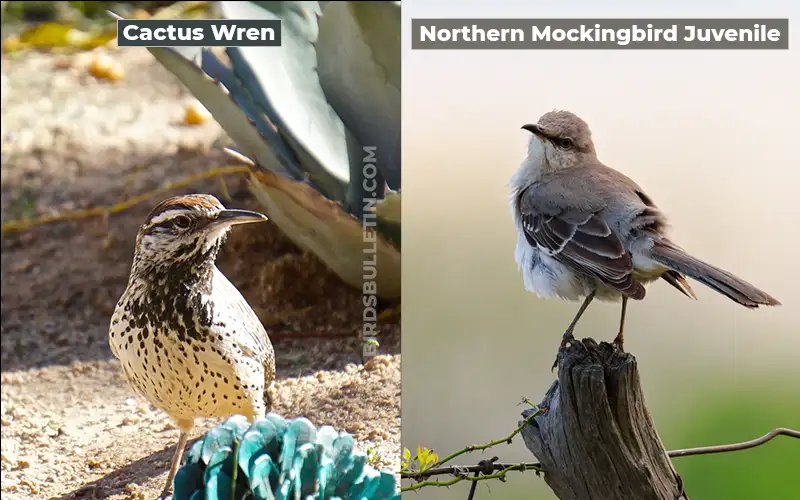
Behavioral Patterns and Favored Regions
While juveniles range widely across the continental U.S., northern mockingbirds occupy more open forests andEDGEs rather than deserts. Adults also display characteristic white patches on the wings visible during flight.
Subtle Discrepancies
Lacking distinct facial markings, juvenile mockingbirds differ from cactus wrens in voice and behavior as well. Mockingbirds’ incessant mimicry distinguishes them from the rasping call of the cactus wren.
06. Townsend’s Solitaire
Descriptive Characteristics
About the same size as a cactus wren, Townsend’s solitaire exhibits drab gray-brown plumage accented by white outer tail feathers visible in flight. A bold eye ring offers a key field mark.
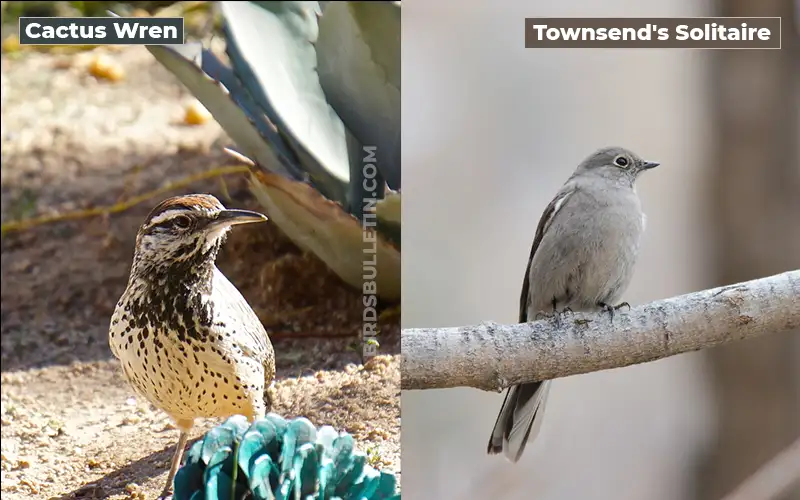
Range and Habitat
Most often found occupying coniferous mountain forests rather than desert scrub, Townsend’s solitaires breed primarily in western mountain ranges as far north as Alaska before migrating to wintering grounds in the southern U.S. and Mexico.
Differences from Cactus Wren
Lacking rusty brown tones or distinct facial markings, solitaires differ markedly from cactus wrens in plumage. Their haunting, warbled songs sung from treetops also set them apart from cactus wrens.
07. American Dusky Flycatcher
Appearance
Approximately the same size as a cactus wren, the dusky flycatcher sports a medium gray-brown body, dark tail with rufous edges, and pale-yellow belly. Two subtle wingbars stand out at close range.
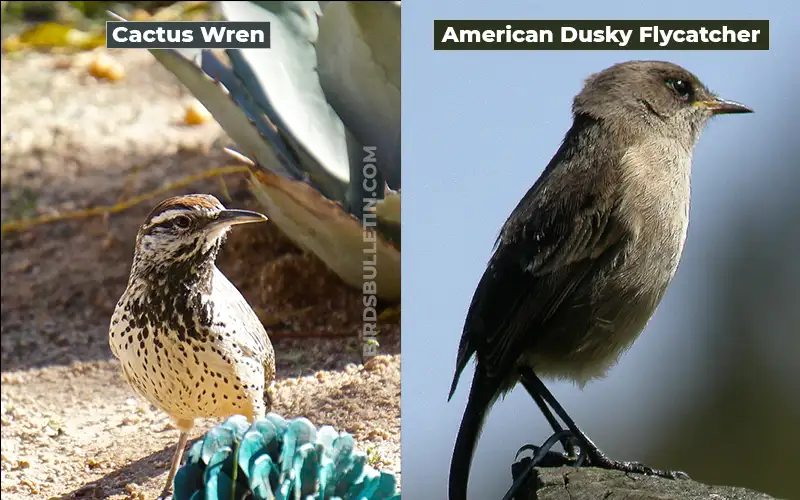
Habitats and Distribution
Unlike cactus wrens, dusky flycatchers occupy forest and woodland rather than desert scrub. Their breeding range stretches across northern North America, while they winter primarily in Mexico and Central America.
Variations from Cactus Wren
With more subdued plumage overall, duskies lack the crisp markings and warm brown hues of cactus wrens. Their preference for perches instead of scrubby desert vegetation offers another clue.
08. Female Mountain Bluebird
Appearance and Identification
Lacking the brilliant blue hue of males, female mountain bluebirds appear grayish-brown overall with a muted orange breast and white belly. Their voices sharply diverge from cactus wrens as well.
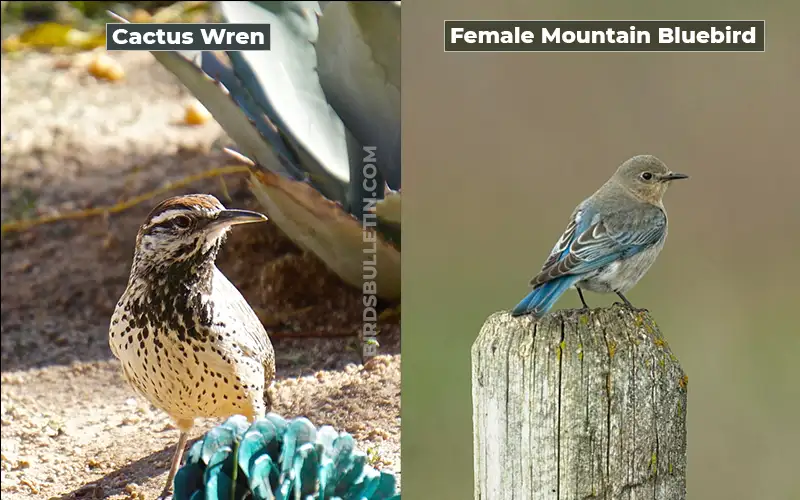
Habitats and Distribution
Although they occupy an open country, female mountain bluebirds frequent grasslands, meadows, and forest clearings rather than desert habitats. Their breeding grounds center on western mountain ranges.
Variations from Cactus Wren
The muted orange breast readily distinguishes female mountain bluebirds from the more uniformly gray-brown cactus wren. In addition, mountain bluebirds lack rusty coloration and the distinct facial markings of cactus wrens.
Wrapping Up
While several bird species bear a superficial resemblance, key plumage differences, habitat preferences, behavior, and voice separate birds often confused with the cactus wren.
Familiarity with subtle field marks such as wing bars, eye rings, streaking patterns, and tail structure can help differentiate these desert-dwelling songbirds. Proper identification ultimately requires patience along with an appreciation of avian diversity across the landscape.


